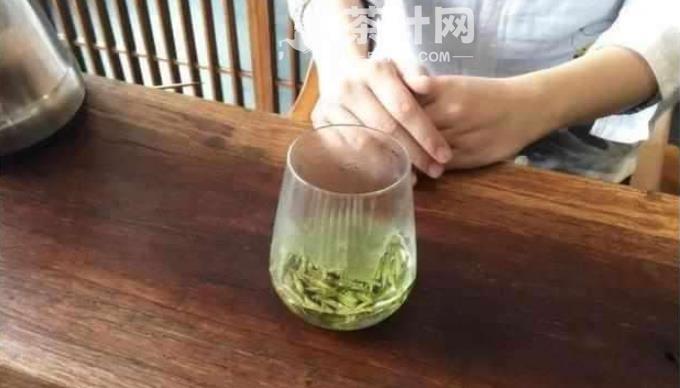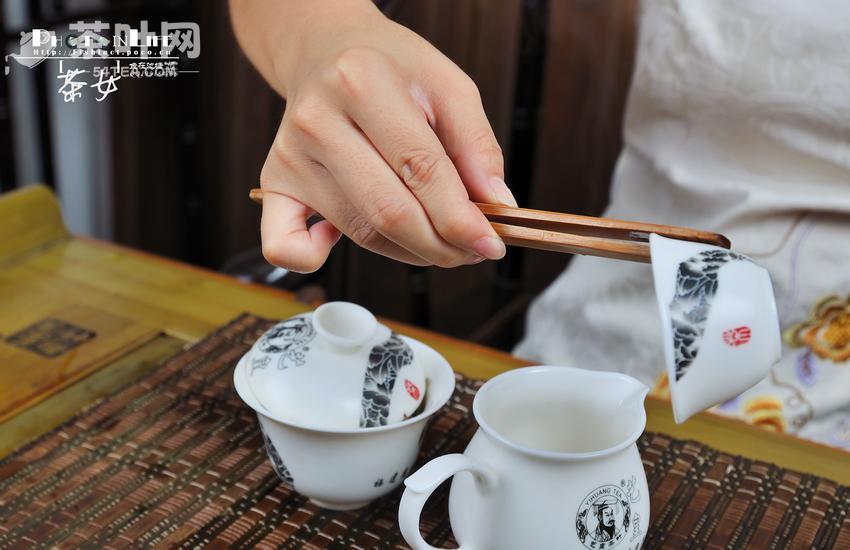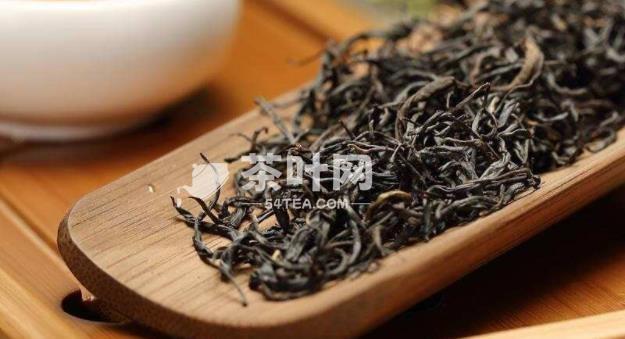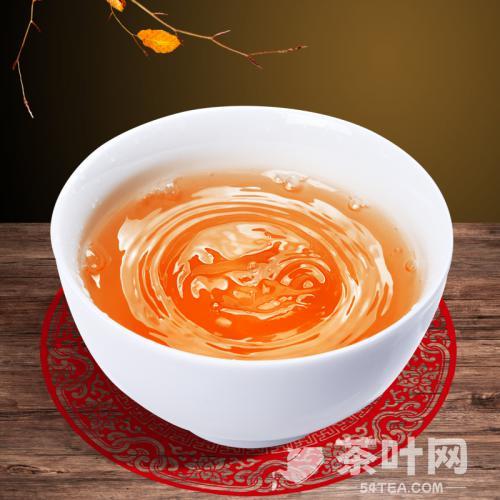Longjing tea tea ceremony program, Longjing tea ceremony narration. nQxTea.com
First, Longjing tea tea art utensils selection
Four glass cups, a white porcelain pot, a set of electric hand bubble, a tin tea canister, a set of tea props, stripped lacquerware tea tray, a ceramic tea pool, an incense burner, incense – branch, a tea towel, the special grade Longjing (Lion Peak) 12 grams. nQx tea net
 nQxtea.com
nQxtea.com
Second, Longjing tea performance 12 procedures
1. incense – burning incense in addition to delusion nQx tea net
2. wash the cup – ice heart to the dust nQxtea.com
3. Cold Soup – Jade Kettle nQxTea.com
4. Throwing tea – the Qing official to welcome the beautiful nQxTea.com
5. Moistening the tea – manna moistens the lotus heartnQxtea.com
6. Brewing – Phoenix Three Nods nQxTea.com
7. Brewing tea – Jasper sinks into the clear river nQxTea.com
8. Serving tea – Guanyin holding five bottles nQxTea.com
9. Appreciate Tea – Spring Wave Showing Flag Gun nQxTea.com
10. Smell the tea – the wisdom of the heart to realize the fragrance of tea nQxtea.com
11. Tasting tea – tasting the flavor in light nQxtea.com
12.Thank you for the tea – self-pouring enjoyable nQxtea.com
 nQxtea.com
nQxtea.com
Third, Longjing tea performance narration
“Heaven above, Suzhou and Hangzhou below”, the West Lake Longjing is known as the paradise on earth known as Hangzhou’s famous specialty, the Qing Dynasty tea-loving Emperor Qianlong tasted Longjing tea, wrote a poem of praise, said: “Longjing new tea Longjing spring, – the family flavor called cooking: inch buds born from the rotten The tea is roasted in the season before the rainy season. nQxTea.com
Why should the wind ball boast imperial tea, chat because the bird’s tongue moist heart lotus.” Today, we invite you to be back to the emperor to get addicted to, taste a moist as lotus heart of Longjing tea, and enjoy the Longjing tea tea art. nQxTea.com
The first course: burning incense in addition to delusion nQx tea net
As the saying goes, “Brewing tea can cultivate your body and nourish your character, and tasting tea is like savoring life.” Ancient and modern tea are concerned about the first to calm the mind. “Burning incense in addition to delusion” that is, through the lighting of the incense to create a peaceful and solemn atmosphere, and to achieve the drive away delusions, the purpose of peace of mind. nQx tea net
The second course: Ice heart to go to the dust nQxTea.com
Tea is the most clear and clean, the sky connotes the spirit of the earth. Brewing tea requires that the vessels used must be clean to clean: this procedure is in front of the guests, the original is in the face of the clean glass cup and then hot wash again, to show respect for the guests. nQxtea.net
The third course: the jade pot to raise the peace nQxtea.com
Today we brewed the Lion Peak Longjing tea buds are extremely delicate. If directly with sweat brewing, will be scalded tea buds caused by cooked soup loss of flavor, so we put the boiling water first into the porcelain pot to raise a while. To be the water temperature down to about 80 ℃ and then used to brew tea, with such a warm, not hot, just the right amount of water out of the tea only color and flavor are beautiful. nQx Tea Net
The fourth way: Qing Palace to welcome the beautiful nQx tea network
Su Dongpo has a poem: “play as a small poem Jun do not laugh, never good tea like a good person,” he compared the quality of tea to let a person fall in love at first sight of a perfect woman. “Qing Palace to welcome the beautiful people” that is, using a teaspoon to tea leaves into the icy clean glass cup. nQx Tea Net
The Fifth Ceremony: Manna Moistening Lotus Heart nQxTea.com
The tea leaves are put into the icy glass with a teaspoon and the tea leaves are put into the icy glass with a teaspoon and the tea leaves are put into the icy glass. nQxTea.com
The Sixth Ceremony: Phoenix Three Nodding nQxTea.com
Brewing Longjing is also about high flushing water. When brewing, the kettle rhythmically rises and falls three times without stopping the flow of water, this brewing technique is called the phoenix three nods, meaning the phoenix nods its head to the guests again and again. nQxTea.net
Seventh course: Jasper sinks into the clear river nQxTea.com
Longjing tea absorbs water after flushing. Gradually by stretching out and slowly sink to the bottom of the cup; we call it “Jasper sinks into the clear river” nQxtea.com
The eighth course: Guanyin holding a jade bottle nQxtea.com
In Buddhist stories, it is said that Guanyin, the Goddess of Mercy, often holds ten white jade bottles, and the nectar in the bottles can eliminate calamities and diseases, and save pieces of the world. This procedure is for the tea lady to offer tea to the guests, which is meant to bless the good people with a lifetime of peace. nQxtea.net
The Ninth Course: Spring Wave Show Flag Gun nQxTea.com
The hot water in the cup is like spring waves, under the hot water, the tea buds of Longjing tea slowly spread out, pointed tea buds like a gun, unfolding the leaves like a flag. A bud of one leaf called “flag gun”, a bud of two leaves called “bird tongue”, unfolding the tea buds cluster at the bottom of the cup, in the clear blue quiet water or up and down, or swaying, vivid, like the first bloom of spring orchids, but also seems to have the life of the green elves dancing, so some tea people say that this feature is not only the tea buds, but also the tea buds, the tea buds, the tea buds, the tea buds, the tea buds. Therefore, some tea people call this characteristic program as “watching tea dance in the cup”, which is very vivid and interesting. nQx Tea Net
The tenth course: the heart to realize the fragrance of tea nQxtea.com
Longjing tea has four distinctive features: green color, beautiful shape, lush fragrance, and mellow taste. So we drink Longjing to see, smell, taste. Just now we see Ding cup of tea dance, now to smell the tea. Longjing tea aroma is as rich as orchid face than orchid, smell tea, Emperor Qianlong described as “ancient plum to me blowing the fragrance”, let’s let us carefully sniff again, to see if we can find this kind of tea aroma attacking people’s senses. nQxTea.net
The eleventh course: tasting the flavor in the light nQxTea.com
Drinking Longjing is also extremely delicate, the Qing Dynasty tea man Lu Ji Zhi said: “Longjing tea, the real sweet and not cold, sip the light, seems tasteless, after drinking, feel a kind of peace of gas, 弥沦 in the teeth and cheeks, this tasteless taste, and even taste.” Please slowly sip, savor, so that the Dragon Well tea and gas into our lungs, so that we live longer. Let the “tastelessness” of Longjing tea enlighten our spirituality, so that we have a deeper sense of life. nQxTea.net
The twelfth course: self-pouring endless joy nQxtea.com
The joy of tea tasting is in the leisure and contentment. After the first course of tea, our tea ceremony will come to an end, then please pour your own tea, through hands-on, from the tea activities to feel the cultivation of the body, taste the endless joy of life. nQxTea.com
 YKh Tea
YKh Tea
















